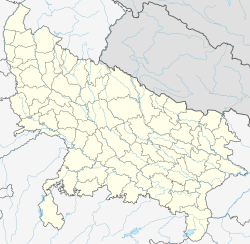Top Qs
Timeline
Chat
Perspective
Shri Naimishnath Vishnu Temple
Hindu temple From Wikipedia, the free encyclopedia
Remove ads
Shri Naimishnath Vishnu Temple, also known as the Naimishnath Devaraja temple or Naimishnarayan Temple or Ramanuj Kot Temple is a Hindu temple dedicated to Lord Vishnu and Goddess Lakshmi located in Uttar Pradesh in Naimisharanya town, Sitapur district.[1] It is one of the Divya Desams, the 108 temples of Vishnu revered in Nalayira Divya Prabandham by the 12 poet saints called the Alvars, specifically Thirumangai Alvar. Technically, the whole city is considered a Divya Desam, not just the temple.
The temple is believed to be of significant antiquity with contributions at different times from various ruling kings. The temple is counted as one of the eight temples of Vishnu that self-manifested and is classified as Swayamvyaktha Kshetra. The holy teerths Chankra Kunda and Gomati river are associated with the temple and it is a pilgrimage centre where people take a holy dip during festive occasions. Ahobila Matt’s Nava Narasimha Swamy Hanuman Garhi temples are also located nearby.
Remove ads
Legend
Indra, the king of the devas, was once driven out of Devaloka by an asura named Vritra. Vritra was granted the boon that he could not be killed by any weapon that was known till the time of the boon; additionally that no weapon made of wood or metal could harm him. On the advice of the god Brahma, Indra performed penance to the god Vishnu at the Naimish forest for 2000 years. Pleased, Vishnu appeared before Indra and revealed that only the weapon made from the bones of the sage Dadhichi would defeat Vritra. Indra requested the sage for his bones; the sage acceded the request and sacrificed his life. Indra created the vajra (thunderbolt) from the sage's spine and slew Vritra.[2]
Remove ads
Location and Architecture
Summarize
Perspective

Naimisaranya is located at the junction of the roads from Sitapur and Khairabad, 32 km from Sitapur and 42 km from the Sandila railway station, 45 miles north of Lucknow in Uttar Pradesh. Naimisaranya is also known as Nimsar or Nimkhar and is located on the left bank of the river Gomati.[3]
The Namishnath Vishnu temple is constructed in South Indian architectural style with a Gopuram outside, while exhibiting North Indian architectural features inside. It boasts a golden Garuda stambh facing Lord Vishnu in the garbagriha, with the Garuda murti engraved on it. It has small Sabha mandap connected with garbagriha. There are three garbagrihas dedicated to Lord Vishnu, Sri Lakshmi, and Jagadguru Ramanujacharya. All the three garbagrihas are aligned adjacently.
The mool garbagriha of Lord Vishnu, made of black stone, in standing posture facing Garuda stambh. There is chal (utsava) vigrahas of Lord Vishnu with Sridevi and Bhudevi standing beside Him, made of Panchaloha. The murtis are richly decorated in ornaments.
Here, Mahalakshmi is Pundarikavalli also fondly called Naimish-Lakshmi ji, covered in red clothes and jewelry. It is located on the left of Lord Vishnu's shrine with Ramanujacharya's shrine in the right side. All the shrines have steel gates.
Remove ads
Religious significance
Summarize
Perspective

This place has also been visited by Shankaracharya[4] and the famous poet, Surdas resided here. Maharishi Suta, the author of 18 puranas is believed to have lived here and presented his sayings to the sages. The forest is considered to be under the divine guardianship of Lord Vishnu, and therefore, the puja (ritual worship) offered to him is regarded as an act of reverence toward the sacred grove itself.[5]
The temple is counted as one of the eight temples of Vishnu that self-manifested and is classified as Swayamvyakta Kshetra.[6] (Seven other temples in the line are Srirangam Ranganathaswamy temple, Bhu Varaha Swamy temple, Tirumala Venkateshvara Temple, and Vanamamalai Perumal Temple in South India and Saligrama (Muktinath Temple), Pushkar(Varah temple) and Badrinath Temple in North India).[7] Naimishnath Vishnu temple is revered in Naalayira Divya Prabandham, the 7th–9th century Vaishnava canon, by Thirumangai Alvar in ten hymns. The temple is classified as a Divya Desam, the 108 Vishnu temples that are revered in the Vaishnava canon. It is one of the 5 major Vaishnavite temple located in the state of uttar pradesh along with Ram Janmabhoomi Temple (Ayodhya),Krishna Janmbhoomi Temple (Mathura),Kamtanath Temple (Chitrakoot) and Beni Madhav Temple (Prayagraj).
Every new moon day, a large number of people purify themselves with a dip in the holy well. If the new moon falls on a Monday, it is believed that a holy bath in the well and offering to the nearby deity Lalita will wash away all the sins committed in their lifetime.[2]
Naimisharanya’s Chakra Tirtha is a remarkably unique hydrological feature where water emerges from an underground source and flows in a circular motion. It is revered as the spot where Lord Vishnu’s Sudarshana Chakra touched the earth.
See also
Notes
References
External links
Wikiwand - on
Seamless Wikipedia browsing. On steroids.
Remove ads


